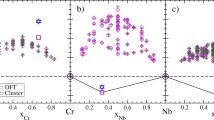Abstract
Miscibility gaps appear in many alloy systems and, consequently, spinodals and critical points. Three methods are presented for determining a critical point in a multicomponent system. The first method is Gibbs thermodynamic conditions for spinodal and critical point. The spinodal is where the determinant of Gibbs energy Hessian equals zero. The critical point is on the spinodal and where the determinant of another matrix, the Gibbs energy Hessian with any one row replaced by the gradient of the determinant of Gibbs energy Hessian, also equals zero. The second method for a critical point uses the fact that the third directional derivative of the Gibbs energy along the eigenvector direction of Gibbs energy Hessian must be zero at a critical point. The third method uses the geometric features of binodal, spinodal, and eigenvector of Gibbs energy Hessian to determine the position of a critical point on a spinodal curve. The conditions for a spinodal and a critical point in a multicomponent system can be expressed in terms of directional derivatives of Gibbs energy, which are the natural extension of the binary conditions. The ternary Al-Cu-Sn alloy system is used as an example to demonstrate how to apply these conditions to determine the critical points and critical lines. A proof is given in Appendix for the gauge invariance of the determinant of the Gibbs energy Hessian.





Similar content being viewed by others
References
J.W. Gibbs, The Scientific Papers of J. Willard Gibbs, Vol. I, Thermodynamics, ed. by H.A. Bumstead and R.G. Van Name (Dover Publications, NY, 1961) pp. 129–134.
J.W. Cahn, On Spinodal Decomposition, Acta Metall., 1961, 9, p 795–801.
J.E. Morral, and J.W. Cahn, Spinodal Decomposition in Ternary Systems, Acta Metall., 1971, 19, p 1037–1045.
J.E. Morral, Stability Limits for Ternary Regular System, Acta Metall., 1972, 20, p 1069–1076.
D. de Fontaine, An Analysis of Clustering and Ordering in Multicomponent Solid Solutions—I. Stability criteria, J. Phys. Chem. Solids, 1972, 33, p 297–310.
D. de Fontaine, An Analysis of Clustering and Ordering in Multicomponent Solid Solution-II. Fluctuations and Kinetics, J. Phys. Chem. Solids, 1973, 34, p 1285–1304.
J.E. Morral, and S. Chen, Stability of High Entropy Alloys to Spinodal Decomposition, J. Phase Equilib. Diffus., 2021, 42, p 673–695.
D. Mirković, J. Gröbner, and R. Schmid-Fetzer, Liquid Demixing and Microstructure Formation in Ternary Al-Sn-Cu alloys, Mater. Sci. Eng. A, 2008, 487, p 456–467.
D. Mirković, J. Gröbner, and R. Schmid-Fetzer, Solidification Paths of Multicomponent Monotectic Aluminum Alloys, Acta Mater., 2008, 56(18), p 5214–5222.
C.H.P. Lupis, Chemical Thermodynamics of Materials. Prentice Hall, 1993.
M. Hillert, Phase Equilibria, Phase Diagrams and Phase Transformations, Their Thermodynamic Basis, 2nd edn. Cambridge University Press, 2008.
K. Kadirvel, S.R. Koneru, and Y. Wang, Exploration of Spinodal Decomposition in Multi-principal Element Alloys (MPEAs) Using CALPHAD Modeling, Scr. Mater., 2022, 214, p 114657.
S.-L. Chen, S. Daniel, F. Zhang, Y.A. Chang, X.-Y. Yan, F.-Y. Xie, R. Schmid-Fetzer, and W.A. Oates, The PANDAT Software Package and Its Applications, Calphad, 2002, 26(2), p 175–188.
W. Cao, S.L. Chen, F. Zhang, K. Wu, Y. Yang, Y.A. Chang, R. Schmid-Fetzer, and W.A. Oates, PANDAT Software with PanEngine PanOptimizer and PanPrecipitation for Multi-component Phase Diagram Calculation and Materials Property Simulation, Calphad, 2009, 33(2), p 328–342.
U.R. Kattner, John E. Morral (1939–2020), J. Phase Equilib. Diffus., 2021, 42, p 1–2.
Author information
Authors and Affiliations
Corresponding author
Additional information
This invited article is part of a special tribute issue of the Journal of Phase Equilibria and Diffusion dedicated to the memory of former JPED Editor-in-Chief John Morral. The special issue was organized by Prof. Yongho Sohn, University of Central Florida; Prof. Ji-Cheng Zhao, University of Maryland; Dr. Carelyn Campbell, National Institute of Standards and Technology; and Dr. Ursula Kattner, National Institute of Standards and Technology.
Publisher's Note
Springer Nature remains neutral with regard to jurisdictional claims in published maps and institutional affiliations.
Rights and permissions
Springer Nature or its licensor (e.g. a society or other partner) holds exclusive rights to this article under a publishing agreement with the author(s) or other rightsholder(s); author self-archiving of the accepted manuscript version of this article is solely governed by the terms of such publishing agreement and applicable law.
About this article
Cite this article
Chen, S., Schmid-Fetzer, R. & Morral, J.E. Calculation of Critical Points. J. Phase Equilib. Diffus. 43, 968–978 (2022). https://doi.org/10.1007/s11669-022-01014-y
Received:
Revised:
Accepted:
Published:
Issue Date:
DOI: https://doi.org/10.1007/s11669-022-01014-y




